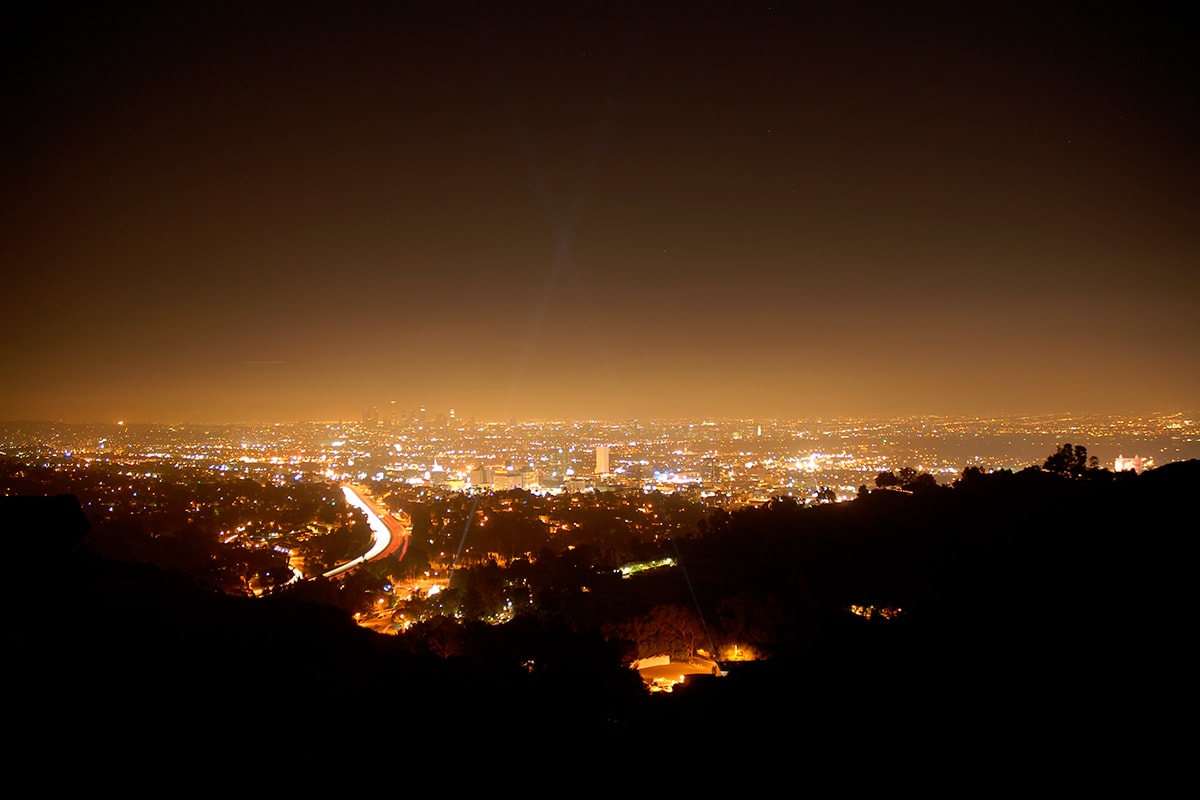What Is Skyglow
Skyglow is the excessive artificial light in the night sky that brightens the atmosphere. It occurs when light from various sources, such as streetlights, buildings, and outdoor lighting fixtures, scatters and reflects, creating a glow that obscures the natural darkness of the night sky. This phenomenon can be observed even in rural or remote locations.
The brightness of skyglow has been increasing at a rate of 9.2-10% annually between 2011 and 2022, with significant ecological, health, and cultural implications.
Sources of Skyglow
While there are natural sources of skyglow, such as a full moon, we will mainly focus on anthropogenic sources caused by human activities.
Light Dome
When we see a light dome over populated areas, that is an example of skyglow. This dome is formed by the combination of various light sources that emit light into the exterior environment. It includes street lights, parking lot lights, building security lighting, interior building lighting from commercial sectors or high-rise buildings, landscape lighting, sports lighting, vehicular lighting, and any other sources that contribute to the brightness of the night sky.
Uplight
Uplight is another aspect related to skyglow. It is the light that travels above a horizontal plane relative to the Earth. This can be light emitted directly from a fixture or light that is reflected from the ground, buildings, or other sources and ends up traveling in an upward direction. When this light enters the sky, it scatters through collisions with air molecules, dust particulate, pollution, and water droplets, contributing to the brightening of the night sky and the overall skyglow effect.
Impacts of Skyglow
Skyglow is a significant issue due to its profound effects on the environment, human health, and astronomical observations. It refers to the excessive brightness of the night sky caused by artificial lighting, which has negative implications for various aspects of our lives.
One of the most important is its impact on the environment. Excessive artificial lighting at night disrupts natural ecosystems and wildlife behavior. Many species rely on natural darkness for their survival, reproduction, and navigation. Skyglow can disrupt these natural patterns, leading to disorientation, altered migration routes, and disrupted breeding cycles. This can have long-term consequences for biodiversity and ecosystem health.
Skyglow also affects human health. Exposure to excessive artificial light at night disrupts our natural sleep-wake cycles and can result in sleep disorders. This disruption has detrimental effects on our overall well-being, including an increased risk of chronic diseases such as obesity, diabetes, and cardiovascular problems.
Furthermore, skyglow poses a significant challenge for astronomers and stargazers. The excessive artificial light in urban areas makes it difficult to observe and study celestial objects. It reduces the visibility of stars, galaxies, and other astronomical phenomena, limiting our understanding of the universe and hindering scientific research. This is particularly concerning as the night sky has been a source of inspiration, wonder, and scientific discovery throughout human history.
Addressing skyglow is crucial for preserving the environment, protecting human health, and promoting scientific research. By implementing responsible lighting practices, such as using shielded fixtures, directing light downward, and reducing unnecessary outdoor lighting, we can minimize skyglow and its negative impacts. Additionally, using energy-efficient lighting technologies and implementing smart lighting systems can help reduce light pollution and save energy.
Frequently Asked Questions
What Color Is Skyglow
In areas with minimal light pollution, the night sky showcases a multitude of stars against a dark backdrop, while clouds take on a dark hue. However, in urban areas where light pollution is prevalent, the stars become obscured and the clouds may appear to have a reddish or orange tint.
How Do You Reduce Skyglow
To reduce skyglow, you can utilize dimmers, motion sensors, and timers. These devices are effective in lowering the average illumination levels and conserving energy. Another option is to switch to LED lighting, which provides reduced illuminance while still maintaining visibility. Additionally, turn off unnecessary indoor lighting, especially in vacant office buildings during the night.
What Is the Negative Effect of Skyglow
Skyglow has negative effects, particularly for astronomers. It significantly diminishes the contrast in the night sky, making it extremely difficult to observe anything other than the most luminous stars.
What Is the Biggest Source of Light Pollution
The biggest contributor to light pollution is the use of outdoor lights that emit light in an upward or sideways direction. When light escapes upwards, unless it is obstructed by a tree or building, it scatters in the atmosphere and creates a brighter night sky, which ultimately hinders our view of it.









